Gregory A. Fournier's Blog, page 27
November 4, 2016
Ambiguity Mars The Jane Mixer Case
 Forty-eight years after the murder of University of Michigan coed Jane Mixer, a University of California San Diego professor believes the man convicted of the crime--Gary Earl Leiterman--may be innocent. After consulting with six DNA experts, Distinguished Professor of Psychology John Wixted has written an article in this month's Association for Psychological Science Observer in support of his belief that contaminated DNA evidence convicted the wrong man.
Forty-eight years after the murder of University of Michigan coed Jane Mixer, a University of California San Diego professor believes the man convicted of the crime--Gary Earl Leiterman--may be innocent. After consulting with six DNA experts, Distinguished Professor of Psychology John Wixted has written an article in this month's Association for Psychological Science Observer in support of his belief that contaminated DNA evidence convicted the wrong man. In 2005, Gary Earl Leiterman was identified through DNA analysis as Mixer's assailant in her March 20, 1968 murder. Mixer's murderer, long held by the public to be John Norman Collins, was exonerated by default when Leiterman was convicted of Mixer's murder thirty-six years after her death.
Perspiration stains found on a nylon stocking tied around Mixer's neck were examined for DNA. The FBI using their CODIS (Combined DNA Index System) database came up with a direct hit on Leiterman. Complicating the DNA evidence in this case was a spot of blood found on Mixer's hand. It matched the blood of John Ruelas, who was only four years old at the time.
The obvious contamination at the crime lab did not sway the jury. They found Leiterman guilty of murder in the first degree after deliberating less than three hours. Since his incarceration, Leiterman has been proclaiming his innocence because of irregularities at the crime lab where the Mixer forensic analysis was done.
Professor Wixted believes Collins may still be the prime suspect in Jane Mixer's murder. He believes there is compelling evidence pointing to Collins's involvement--though there is no hard evidence to support that finding. Leiterman hopes he and his lawyer can get a new trial clearing him of the crime after serving over ten years of his life sentence.
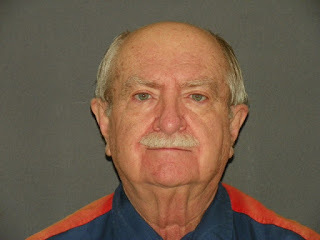 Giving Leiterman hope are updated FBI standards and protocols for DNA labs (Quality Assurance Standards for Forensic DNA Testing Laboratories) effective September 7, 2011. Of its seventeen provisions, #7 Evidence Control, #9 Analytical Procedures, and #14 Corrective Action look the most promising for Leiterman's defense. The new provisions were tightened to ensure the quality and integrity of DNA data generated by these labs. Had these protocols been in place during the Leiterman trial, it is doubtful the DNA evidence would have been admissible in court. What that means for Leiterman's future is yet to be determined.
Giving Leiterman hope are updated FBI standards and protocols for DNA labs (Quality Assurance Standards for Forensic DNA Testing Laboratories) effective September 7, 2011. Of its seventeen provisions, #7 Evidence Control, #9 Analytical Procedures, and #14 Corrective Action look the most promising for Leiterman's defense. The new provisions were tightened to ensure the quality and integrity of DNA data generated by these labs. Had these protocols been in place during the Leiterman trial, it is doubtful the DNA evidence would have been admissible in court. What that means for Leiterman's future is yet to be determined.Professor Wixted's article: http://www.psychologicalscience.org/publications/observer/2016/nov-16/whether-eyewitness-memory-or-dna-contaminated-forensic-evidence-is-unreliable.html
Published on November 04, 2016 10:48
October 28, 2016
The Jane Mixer Murder--John Norman Collins or Gary Earl Leiterman
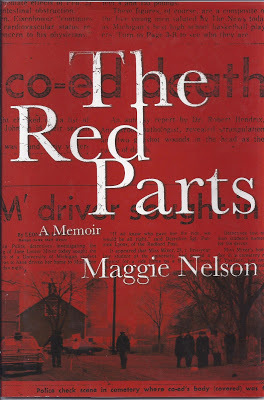 In her profoundly personal memoir, The Red Parts, Maggie Nelson gives readers a glimpse of what lies behind the curtain of American jurisprudence and its affect on the surviving members of one family. Miss Nelson is the niece of Jane Mixer, John Norman Collins' alleged third victim.
In her profoundly personal memoir, The Red Parts, Maggie Nelson gives readers a glimpse of what lies behind the curtain of American jurisprudence and its affect on the surviving members of one family. Miss Nelson is the niece of Jane Mixer, John Norman Collins' alleged third victim.Thirty-six years after Jane's perplexing murder on March 20, 1969, the Mixer family had to endure testimony of the details of her tragic death in a trial held in Wayne County, Michigan, in 2004. For over three decades, Jane's murder was lumped together with the six other unsolved killings in the Ypsilanti/Ann Arbor area, despite fundamental differences including where, how, and what condition the body was found.
Armed with a positive DNA match, as well as convincing circumstantial evidence, Gary Earl Leiterman, a retired male nurse working in Ann Arbor at the time, was found guilt of her murder. John Norman Collins claimed since the beginning he never knew Jane, now he was exonerated for at least one of the seven Michigan murders he was accused of. Even a broken clock is right twice a day.
With unflinching honesty, Miss Nelson tells us the ins-and-outs of her aunt's case with brutal clarity and a benumbing sense of self-awareness that only comes from profound emotional trauma. Early in her book, she asks herself, "Who am I to tell Jane's story?" I can think of nobody better. Later in the book, she finds herself getting drawn into the media vortex of the trial and its aftermath. Miss Mixer has some insightful things to say about American media's fascination with the "dead-white-girl-of-the-week" club.
After reading Maggie Nelson's memoir, I am reminded that disturbing the feelings and memories of the families of the other victims in the Collins case is not to be taken lightly. These girls deserve to be remembered as living human beings, rather than victims of something wicked that happened in another time no longer relevant today. For their memories and what happened to them to simply fade away is unacceptable.
This is Ypsilanti, Michigan history, however unpleasant for some individuals or for the city. The six other murdered girls deserve to have their stories told for the record as well, like Maggie Nelson did for the memory of her aunt, Jane Mixer. I want to honor these lost young women by relating the most accurate account of these matters as possible and bringing some degree of closure to people who cared about these young girls. In the end, the public deserves the truth.
http://www.trutv.com/library/crime/serial_killers/predators/collins/13.html
Published on October 28, 2016 07:46
October 22, 2016
John Norman Collins Trolls Strike Back
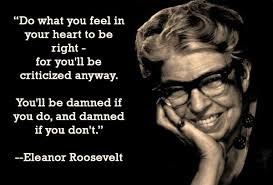
Early on in my writing of Terror in Ypsilanti, my primary goal was to pay a debt to history and restore the real names of the victims which were changed in the novelized treatment The Michigan Murders. John Norman Collins's name was also changed to mask his identity--a courtesy he does not deserve. Many of the people in law enforcement who worked on these cases and others in the know were dissatisfied with Edward Keyes's version. Too many assumptions and presumptions.
Even John Collins criticized the liberties Keyes took with the descriptions of his family and his motivation for committing these crimes--his mother. Collins claims he never read the Keyes book, but how else could he comment on it? In Terror in Ypsilanti, I went easy on the Collins family. They never killed anybody.
Over the five years it took to research and write this book, I received nasty emails from a number of people using ficticous names. For example, one goes by the handle Disrobing Furball. Some complaints came from Collins acolytes and some from fraternity brothers who took exception with any re-examination of these cases. Some few of these guys have reason to feel uncomfortable. They knew or suspected Collins of these crimes early on but remained silent.
Now that my nonfiction treatment of this subject matter is out, these same people have surfaced on my Amazon book page giving me particularly nasty reviews. They stand out because my reviews are overwhelmingly positive, but these have a distinct pernicious quality and are thinly disguised personal attacks. I would regard their comments more seriously if they were informed, and they had placed their real names on their reviews. But they hide behind pseudonyms. All I can say is consider the source.
In a recent Detroit News article [September 27, 2016], Collins claims he hasn't read my book but is quoted as saying it is "HEARSAY AND SPECULATION." For five years, he has refused to speak or meet with me but uses a go-between when he wants to communicate, knowing I'll get word of it. The woman he has chosen for this duty has been corresponding with Collins for years and speaks with him every Tuesday over the phone for fifteen minutes. She and I have been communicating for the last several years and have developed a cordial relationship.
Last Tuesday, Collins phoned and told her he was "Super Pissed! But my Ypsilanti and Center Line friends have my back." Now, I know the source of the toxic reviews. As an author, criticism comes with the territory, and I expect to get my fair share, but personal attacks are a horse of a different color. I welcome all fair and honest remarks and reviews.
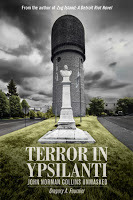 Amazon Terror in Ypsilanti page: https://www.amazon.com/Terror-Ypsilanti-Norman-Collins-Unmasked/dp/1627874038/ref=sr_1_1?s=books&ie=UTF8&qid=1477158434&sr=1-1&keywords=terror+in+ypsilanti
Amazon Terror in Ypsilanti page: https://www.amazon.com/Terror-Ypsilanti-Norman-Collins-Unmasked/dp/1627874038/ref=sr_1_1?s=books&ie=UTF8&qid=1477158434&sr=1-1&keywords=terror+in+ypsilanti
Published on October 22, 2016 11:18
October 14, 2016
Terror in Ypsilanti Media Exposure--On the Air and On the Net
 On October 1, 2016, AM1700 Ypsilanti talk show host Mark Maynard interviewed me about my true crime book Terror in Ypsilanti: John Norman Collins Unmasked. If you were unable to attend one of my recent book talks, this interview is the next best thing. The running length is forty-nine minutes.
On October 1, 2016, AM1700 Ypsilanti talk show host Mark Maynard interviewed me about my true crime book Terror in Ypsilanti: John Norman Collins Unmasked. If you were unable to attend one of my recent book talks, this interview is the next best thing. The running length is forty-nine minutes. The Saturday Six-Pack with Mark Maynard:
https://soundcloud.com/am1700/the-saturday-six-pack-with-mark-maynard-episode-051
 If you don't have a spare hour to listen to my radio interview, Investigation Discovery Crimefeed featured Terror in Ypsilanti in its September online edition. One of my readers put me on to it last week. Here is the link in case you missed it too: http://crimefeed.com/2016/09/new-book-takes-on-the-john-norman-collins-case/?sf35908515=1
If you don't have a spare hour to listen to my radio interview, Investigation Discovery Crimefeed featured Terror in Ypsilanti in its September online edition. One of my readers put me on to it last week. Here is the link in case you missed it too: http://crimefeed.com/2016/09/new-book-takes-on-the-john-norman-collins-case/?sf35908515=1
Published on October 14, 2016 04:40
October 7, 2016
Drew and Mike's Terror in Ypsilanti Podcast
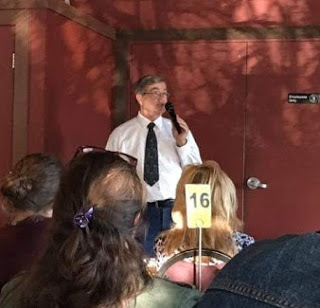 Corner Brewery book talk in YpsilantiThank you to the people who came out to hear me speak about serial killer John Norman Collins last week. Both of my Ypsilanti venues were standing room only, and I sold out my entire Michigan stockpile of Terror in Ypsilanti books. Many people whose names appear in the book were in attendance--several from law enforcement and many who contributed information vital to the factual telling of these terrible events.
Corner Brewery book talk in YpsilantiThank you to the people who came out to hear me speak about serial killer John Norman Collins last week. Both of my Ypsilanti venues were standing room only, and I sold out my entire Michigan stockpile of Terror in Ypsilanti books. Many people whose names appear in the book were in attendance--several from law enforcement and many who contributed information vital to the factual telling of these terrible events. AM 1700 Ypsilanti interviewIn addition to my book talks, I was able to land a front page article in The Detroit News reported by Kim Kozloski on September 27, 2016. On the tail end of my tour, I gave two media interviews, one on AM 1700 broadcasting from historic downtown Ypsilanti and the other by popular Detroit area podcasters Drew and Mike.
AM 1700 Ypsilanti interviewIn addition to my book talks, I was able to land a front page article in The Detroit News reported by Kim Kozloski on September 27, 2016. On the tail end of my tour, I gave two media interviews, one on AM 1700 broadcasting from historic downtown Ypsilanti and the other by popular Detroit area podcasters Drew and Mike.If you were unable to attend my book talks, you may be interested in listening to the following podcast link. My interview starts one hour and twenty-three minutes into the show.
<http://drewandmikepodcast.com/drew-and-mike-oct-6-2016/>
Terror in Ypsilanti: John Norman Collins Unmasked is available in a quality paperback edition on Amazon and other online retailers. The e-book is also available on Kindle, KOBO, Nook, and other digital formats. Autographed copies can be purchased from my website http://gregoryafournier.com.
Published on October 07, 2016 07:12
August 31, 2016
Terror in Ypsilanti - September 2016 Book Talks
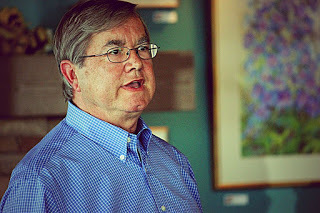 Me speaking at Brewed Awakenings in Saline--April 2016.
Me speaking at Brewed Awakenings in Saline--April 2016.photo: Ryan M. PlaceSeveral Terror in Ypsilanti book talks are planned at the end of September for Southern Michigan. If there is enough demand, I hope to return in the spring and schedule more. Here is what I have scheduled:
September 24th - St. Cece's Brewery [6-8 pm], 1426 Bagley Avenue, Detroit, in Corktown. Over 21 only! Sponsored by Book Club of Detroit.September 27th - The Corner Brewery [5-7 pm], 720 Norris Street, Ypsilanti. Over 21 only!September 28th - Adrian District Library [6:30-8:30 pm], 143 E. Maumee Street, Adrian September 29th - Ypsilanti District Library [6-8 pm], 5577 Whittaker Road, Ypsilanti.October 1st - 1700 AM Radio interview at 6:00 pm.You can purchase autographed copies, but supply is limited to stock on hand. Signed copies can also be acquired at my author website listed below.
Response to TIY has been overwhelmingly positive. My readers say they like the easy-to-read print and the pacing of the book--the words page turner have been used repeatedly. Many people have waited decades for the facts and details of these cases to be presented publicly in a digestible manner. I wish I had all the answers, but only John Norman Collins does. He has chosen to remain silent and take his secrets to the grave.
Come to one of my book talks if you can. I'd like to meet many of you in person and try to answer any questions you may have.
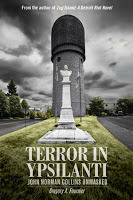
For more information about my books or to buy autographed copies, check out my author website:
gregoryafournier.com
Published on August 31, 2016 14:36
August 24, 2016
Zug Island Novel Gets Facelift
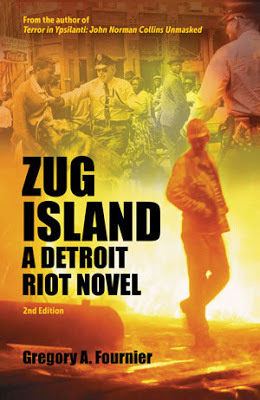 July 2017 marks fifty years since the Detroit Riot left its indelible mark on American history. Anyone who experienced this week of bloodshed and arson can never forget it--43 reported deaths, 7,000 arrests, 4,000 injuries, 2,500 buildings looted or burned to the ground, 5,000 residents left homeless, 16,682 fire runs, and a river of fire ten blocks long.
July 2017 marks fifty years since the Detroit Riot left its indelible mark on American history. Anyone who experienced this week of bloodshed and arson can never forget it--43 reported deaths, 7,000 arrests, 4,000 injuries, 2,500 buildings looted or burned to the ground, 5,000 residents left homeless, 16,682 fire runs, and a river of fire ten blocks long.Zug Island: A Detroit Riot Novel tells the story of two young men, one white and one black, who push the boundaries of race as they explore each others culture. Set in 1967 against a backdrop of industrial blight and urban decay, Jake Malone and Theo Semple get a crash course in race relations as they stumble in and out of rhythm on Detroit's mean streets discovering the face of racism comes in every shade of color.
Kirkus Reviews, a publishing trade magazine, said of Zug Island, "The novel is tightly written with a dramatic plot, well-rounded characters, and clear insights into social history. An engaging, dynamic story that grapples intelligently with the themes of race, class, and morality."
My newly revised 2nd edition has a new cover and includes several enhanced scenes. Since writing Zug Island in 2011, I've learned more about the Detroit communities of Delray, Black Bottom, and Paradise Valley, and the enhanced narrative reflects that. Also new is a segment on the Algiers Motel murders conspicuous by its absence from the original.
Copies are available online from Amazon.com, B&N, and Kindle.
Autographed copies are available at my author website: http://gregoryafournier.com
Published on August 24, 2016 14:55
August 17, 2016
John Norman Collins Kelly & Company Interview
 In 1988, serial killer John Norman Collins gave a television interview from Marquette Branch Prison in Michigan's Upper Peninsula. Years before Ted Bundy, Collins was luring young women to slaughter. From the summers of 1967-1969, Collins murdered a minimum of seven women and left them along the country roadside terrorizing residents in the college towns of Ypsilanti and Ann Arbor. On July 31, 1969, Collins was arrested for the murder of Eastern Michigan coed Karen Sue Beineman.
In 1988, serial killer John Norman Collins gave a television interview from Marquette Branch Prison in Michigan's Upper Peninsula. Years before Ted Bundy, Collins was luring young women to slaughter. From the summers of 1967-1969, Collins murdered a minimum of seven women and left them along the country roadside terrorizing residents in the college towns of Ypsilanti and Ann Arbor. On July 31, 1969, Collins was arrested for the murder of Eastern Michigan coed Karen Sue Beineman. In my nonfiction account of these murders Terror in Ypsilanti: John Norman Collins Unmasked, I reveal the backstory of this rare Kelly & Company [Detroit morning talk show] interview interspersed with commentary by people associated with these cases. John Kelly hosted the studio portion of the show and his co-host [wife] Marilyn Turner flew up to Marquette Prison to conduct the prison interview.
In my nonfiction account of these murders Terror in Ypsilanti: John Norman Collins Unmasked, I reveal the backstory of this rare Kelly & Company [Detroit morning talk show] interview interspersed with commentary by people associated with these cases. John Kelly hosted the studio portion of the show and his co-host [wife] Marilyn Turner flew up to Marquette Prison to conduct the prison interview.All of Collins appeals had run out and his attempt at an international [Canadian] prisoner exchange failed. This was Collins's last chance to take his story to the public and make his case that he was railroaded by an overzealous prosecutor and a rogue county sheriff.
Collins was in control of the interview until Marilyn Turner blindsided him with "Did you love your mother, John?" With that single question, Turner cut through his self-protective stratagems. For the rest of the interview Collins was sullen and disoriented. When the studio audience was polled at the end of the show, votes ran 2 to 1 against Collins. John's roll of the dice to manipulate the media came up snake eyes.
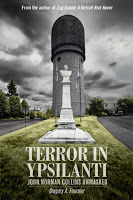 John Kelly and Marilyn Turner1988 Kelly & Company John Norman Collins interview [44 minutes]: https://youtu.be/JfD3O69PCvw
John Kelly and Marilyn Turner1988 Kelly & Company John Norman Collins interview [44 minutes]: https://youtu.be/JfD3O69PCvw Terror in Ypsilanti: John Norman Collins Unmasked true crime book: gregoryafournier.com also available on Amazon, B&N, and other online booksellers. A Kindle edition will be available soon. It takes a couple of weeks for a new title to work its way into the system.
Published on August 17, 2016 07:00
August 14, 2016
Terror in Ypsilanti Ships

On Friday, August 12th, I took shipment of 500 copies of Terror in Ypsilanti: John Norman Collins Unmasked. Readers who have been waiting weeks for their copies should expect their books in the mail this week. I spent Friday and Saturday getting them ready for USPS pickup on Monday. I would like to note that TIY is made in America.
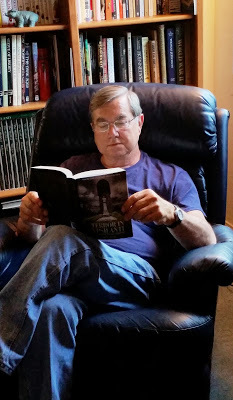 It has been said "Body odor and excuses--everybody's got some." When my book was sent to the printer, it went on their printing schedule. The contract states in small print that orders of 500 or more copies take a minimum of two weeks. There you have it. Now that I have inventory, future wait times for shipment should be no more than a week.
It has been said "Body odor and excuses--everybody's got some." When my book was sent to the printer, it went on their printing schedule. The contract states in small print that orders of 500 or more copies take a minimum of two weeks. There you have it. Now that I have inventory, future wait times for shipment should be no more than a week.For people wanting to purchase multiple copies, amazon.com will save you postage, especially if you have Amazon Prime. A Kindle edition will be available soon. Some last minute revisions are being made. The book lists for $22.95 on Amazon and $9.95 on Kindle.
BarnesandNoble.com also sells TIY online. For bulk orders, contact Wheatmark.com for discounts.
I'm selling individual autographed copies on my website for an introductory price of $20 [plus postage and handling] for a limited time. I can't thank my readers enough for your patience.
If you are so inclined, run a photo of yourself with a copy of TIY and post it on your social media. That would help spread the word about my book. Writing a review for Amazon or goodreads.com would be most appreciated as well.
My author website: gregoryafournier.com
Published on August 14, 2016 08:24
August 3, 2016
Michigan Homegrown Terrorism of the 1930s--The Black Legion
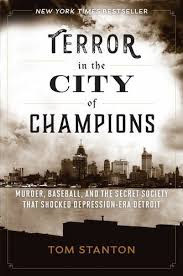 I like to think I am well-versed in Michigan and Detroit history, but it wasn't until I recently read Tom Stanton's Terror in the City of Champions that I learned of the Black Legion, a splinter group of the Ku Klux Klan. The original group called the Black Guard was founded in the mid-1920's as a security force for Ohio Klan officers.
I like to think I am well-versed in Michigan and Detroit history, but it wasn't until I recently read Tom Stanton's Terror in the City of Champions that I learned of the Black Legion, a splinter group of the Ku Klux Klan. The original group called the Black Guard was founded in the mid-1920's as a security force for Ohio Klan officers.After being kicked out of the Klan for establishing a fiefdom, Dr. Billy Shephard from Lima, Ohio, further radicalized the group. They became the Black Legion, an even more ruthless and reckless organization than the Klan. In 1931, a Michigan regiment was established by Arthur Lupp of Highland Park.
From there, Virgil "Bert" Effinger began to reorganize the group throughout the Midwest and became the group's spokesperson. Every new member had to repeat an oath "In the name of God and the Devil." They were given a .38 caliber bullet cartridge and told another one had their name on it if they violated their vow of secrecy.
Some people were tricked into joining by friends or family and soon discovered they were in over their heads. High-ranking officers wore black capes with gold trim and brandished weapons openly. The legion expanded aggressively through deception, threats, and brutality. Beatings and torture were used to keep errant members in line.
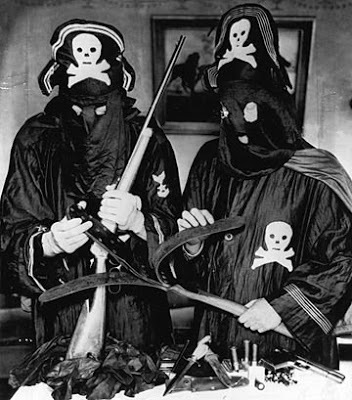 Policemen display captured Black Legion vestments and the tools of their trade.
Policemen display captured Black Legion vestments and the tools of their trade.The Black Legion boasted having over one million members nationwide. At its height in Michigan, there were 5 brigades, 16 regiments, 64 battalions, and 256 companies. Law enforcement estimated membership at 20,000 to 30,000 statewide. The Detroit area had 10,000 members. Michigan State Police investigator Ira Holloway Marmon discovered Black Legion strongholds in Highland Park, Ecorse, Wyandotte, Lincoln Park, Saline, Monroe, Irish Hills, Pontiac, Flint, Saginaw, and of course, Detroit. Indiana, Illinois, and Ohio had active chapters also.
Their members were primarily angry, white, Anglo-Saxon males who were transplants from the South during the boom years of the auto industry in what history marks as the Great Migration. Whites and blacks with little or no industrial skills flooded into Detroit heeding Henry Ford's clarion call, "Jobs at $5 a day." Competition for work was fierce in the 1920s, but during the Great Depression, people were killed over jobs.
The legion was frustrated by the economic and social instability of the 1930s. They felt alienated by Detroit's industrial landscape. One of their core beliefs was that Anglo-Saxon Protestants were being pushed aside in America because foreigners [Catholic and Jewish immigrants] and blacks were taking their jobs--jobs they believed they were entitled to.
Being in the legion made members feel connected with something larger than themselves. Membership for many people increased their self-esteem and sense of white supremacy. They absolutely believed race mixing was destabilizing the American way of life leading to social degeneracy.
Legionnaires widened the scope of their wrath to include terrorizing and often murdering welfare recipients, labor union organizers, and political opponents. Probably more than anything else, the Black Legion hated socialists and communists. The legionnaires were an early Let's make America great again! movement. But theirs was a secret terrorist society.
Using fronts like the Wayne County Rifle and Pistol Club [members honed their shooting skills in the club's backroom firing range] and the Wolverine Republican Club [where thinly disguised rallies and gatherings were staged], Legion-approved speakers would rail against their perceived enemies and rally the faithful. New recruits would hear lengthy diatribes whipping the crowd to a frenzy of hatred.
The legion provided easy answers to the complex questions of their day. One of their political fliers read, "We will fight political Romanism [Catholics], Judaism [Jews], Communism [Socialists], and all 'isms' which our forefathers came to this country to avoid," all the while wrapping themselves in the American flag.
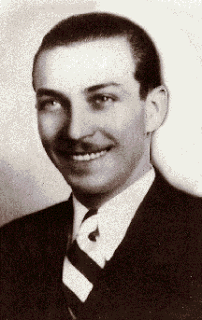 Charles PooleWorks Progress organizer Charles Poole [22 year old Catholic] was shot five times at point blank range in Dearborn Township on May 13th, 1936. A number of key Legion members were arrested and convicted.
Charles PooleWorks Progress organizer Charles Poole [22 year old Catholic] was shot five times at point blank range in Dearborn Township on May 13th, 1936. A number of key Legion members were arrested and convicted.Investigators uncovered the organization's propaganda, their enrollment records, some Black Legion robes and hoods including the tools of their trade--guns, bludgeons, blackjacks, and whips. Dayton Dean was convicted of being the trigger-man in Poole's death. Once on the stand, Dean sang like a canary.
For more details on the Black Legion, view this link: http://www.veteranstoday.com/2012/11/28/history-the-black-legion-where-vets-and-the-klan-met/
In 1937, Warner Bros. Pictures made a movie about the Black Legion starring Humphrey Bogart. http://www.imdb.com/title/tt0027367/
Published on August 03, 2016 05:25



